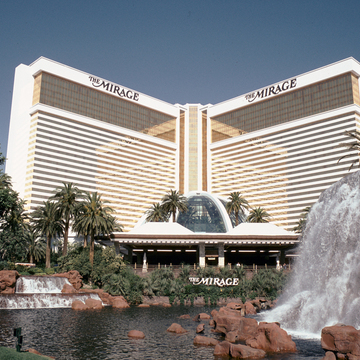The luxurious Mirage triggered a building boom in the early 1990s that continues unabated. The brainchild of casino owner Steve Wynn, the Mirage is geared toward high rollers but also entertains passersby on the sidewalk with a volcano that erupts every fifteen minutes in a blaze of red lights, water, steam, and gas-jet flames. The casino's three-wing, thirty-story tower, containing more than 3,000 rooms, rises monotonously in horizontal bands of white beams and gold-tinted windows, reaching to a simple frieze decorated only with the hotel's name. The complex has the requisite roadside sign, an electronic, rather than neon, signboard rising to a height of 160 feet. Set at the bend in Las Vegas Boulevard, the sign serves as a distance marker on the Strip.
The bulk of the casino stands far back from the street but beckons tourists with a large lake surrounding the volcano. A causeway over the lagoon leads visitors to the porte-cochere. Hotel guests register at a counter to the right of the entrance. Behind the clerks extends a long tropical fish tank containing specimens beautyful enough to distract guests while they wait. When they return to the hotel's main axis, immediately inside the entrance door, they see directly in front of them a tropical rain forest of palms, ferns, orchids, a waterfall, and Chinese-style statues in an atrium 90 feet tall, covered by a glass and metal dome. The casino games begin only beyond that point, as the
Other attractions, located beyond the gambling areas, include Asian restaurants designed to look like garden pavilions in China and Japan, a dolphin pool, and a white-tiger habitat extending from an artificial white cave indoors to an outdoor garden. A spacious convention center, often a feature of casino hotels, is decorated with tasteful examples of modern Japanese art and craftsmanship. These continue the casino's exotic theme, emphasizing the tropical fantasy aspects of a place that actually rises from the desert.




















